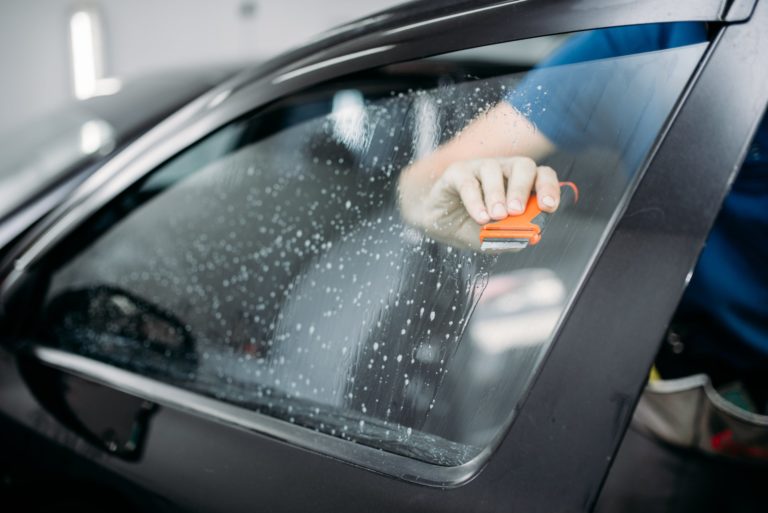Window tinting has emerged as a highly valued investment for both car owners and homeowners due to the multitude of benefits offered by window tint films. These advantages encompass enhancements to the visual appeal of vehicles or homes and the safeguarding of occupants, as well as the interior of the home and vehicle, against the detrimental effects of the sun’s UV rays.
However, like all things, window tints experience degradation over time, and their durability hinges upon factors such as the quality of the tint and installation, the extent of heat or sun exposure, and regular maintenance. Consequently, issues may arise with your tints as they age.
Most Common Window Tint Issues
Although tinting your windows offers advantages like reduced maintenance time and cost, it remains essential to conduct regular care and maintenance on the tint films. Proper care and maintenance can enhance the lifespan of your window tint, ensuring continued benefits. Conversely, neglecting maintenance can lead to minor cosmetic problems with the tint film over time.
Let’s have a look at the most common issues associated with window tints:
Peeling
Peeling is a common occurrence after a few years, but if window film begins to peel shortly after application, it indicates improper installation. Typically, window film starts to peel off once the adhesive hardens from exposure. This peeling may be minimal or extensive, causing the entire film to detach.
If you attempted self-installation, you may have used incorrect or weak adhesives that failed to securely bond the tint. Diluted glue lacks the strength to adequately support the film, causing it to slide off the glass.
Alternatively, installing the film under unfavorable conditions, such as on a wet car surface or excessively hot windows, can hinder proper adhesion. In such cases, the tint fails to adhere to the adhesive effectively.
Professional installation significantly reduces the risk of peeling, ensuring proper adherence and longevity of the window film.
Discoloration
Discoloration is another common issue encountered with DIY window tinting. Window films are consistently exposed to UV rays and sunlight, subjecting the materials to considerable stress. Lower-quality dyes tend to fade rapidly and may develop a purple tint over time. If your tint begins to exhibit purple hues, it’s an indication that the dye used was either incorrect or of inferior quality.
Improper application can also result in tints becoming cloudy or hazy. This often occurs when the car surface is wet during installation. The trapped water beneath the tint evaporates, causing cloudiness throughout the film. In such instances, seeking professional assistance is advisable, as cloudy surfaces impair visibility and pose a potential hazard on the road.
Bubbling
Bubbling is a common issue that can occur in window film over time. However, if bubbles appear immediately after installation, it’s typically a sign of an underlying problem. Often, bubbles form due to exposure to dirt. If any spots of grime are overlooked before starting the installation, they can cause the tint to trap surrounding air, leading to expansion.
Bubbles not only detract from the appearance of the window film but can also cause distractions while driving. They obstruct light rays and can distort them, compromising visibility on the road. To prevent bubbles from appearing in your tint, it’s best to seek the assistance of a professional installer.
Gapping
Gapping is a common issue encountered when attempting DIY window tint installation. You may notice small gaps or uneven areas after completing the installation process, which are prevalent in DIY projects. Keep an eye out for irregular lines around window edges or door handles, as these are commonly overlooked areas.
Correcting these gaps may require removing all of the tints and starting over, which can be more costly than initially opting for a professional application. Professional tint installers typically utilize computerized templates to ensure precise application. Therefore, it’s advisable to hire a professional for the most meticulous window film installation.
Hard Water Spots
Hard water spots, a common nuisance for surfaces exposed to heat, arise when water evaporates, leaving behind concentrated mineral deposits. These deposits are often challenging to see through due to their density and can pose a significant challenge when attempting to remove them.
When driving, these stubborn spots can obstruct your visibility, creating potential hazards on the road. Moreover, when trying to enjoy the scenic views outside your home, these unsightly deposits can detract from the overall aesthetic appeal, hindering your ability to fully appreciate your surroundings.
There are several options for removing hard water stains from your window tints. In addition to using mild window cleaning products, you can also try DIY solutions to clean the windows effectively.
Temperature Issues
Temperature issues can arise with window tinting, which is typically valued for its ability to regulate temperature. Following installation, your vehicle or building naturally adjusts to excess heat and cold. However, if you notice your car or room feeling stuffy or excessively cold a few days after application, it likely indicates a faulty installation. The film may be impeding proper air circulation, which can be counterproductive.
To address this issue, it’s advisable to seek assistance from a specialist for safe removal. Once the correct film application is applied, you should experience improved temperature control, resulting in a cooler and more comfortable environment in your residence or car.
Adhesive Issues
Challenges with adhesive, such as sticky residues or inadequate bonding, can complicate window tinting projects. Sticky residues often stem from the use of low-quality adhesives or improper application techniques. Addressing this requires gently heating the adhesive with a hairdryer and cautiously scraping it off with a razor blade, taking care to avoid damaging the window glass.
When the tint fails to adhere properly, it may be due to a dirty window surface or the use of inferior tint materials. Preventing these issues involves ensuring the window is thoroughly clean and dry before application and selecting a high-quality tint with a strong adhesive. If problems persist, it may be necessary to remove the tint and reapply it or seek assistance from a professional.
How to Overcome Window Tint Issues
To ensure the optimal appearance and performance of your window tint films, it’s essential to proactively address any emerging issues. Here are some valuable tips to effectively tackle common problems associated with window tints:
1. Invest in Quality Tinting Film:
Ensure that the window tinting film you choose is of high quality. Opting for cheap alternatives may lead to bubbling or peeling over time, compromising both aesthetics and functionality.
2. Handle Windows with Care:
Exercise caution when rolling down your car windows, especially if you have sharp nails or objects near them. Abrasive contact can cause scratches or peeling of the tint, detracting from its longevity and appearance.
3. Seek Shade for Protection:
When it comes to preserving your car’s window tints, choose shaded areas when parking to minimize prolonged exposure to direct sunlight. Continuous sun exposure can accelerate the fading of the window tint, diminishing its effectiveness and visual appeal.
4. Maintain Cleanliness:
Regularly clean your tinted windows using a mild soap and water solution. This prevents dirt and grime buildup, which can contribute to bubbling or peeling of the tint over time. Keeping your windows clean ensures both the clarity and durability of the tint.
5. Address Issues Promptly:
If you encounter any problems with your window tint, such as bubbling, peeling, or fading, don’t delay in seeking assistance. Return to the shop where the tint was installed to have the issue resolved professionally. Timely intervention can prevent further damage and maintain the integrity of your window tint for the long term.
With these preventive measures, you can mitigate common window tint issues and enjoy the benefits of a sleek, protected vehicle for years to come.
The Bottom Line
Window tinting is a valuable investment, offering both aesthetic enhancement and practical advantages. However, like any investment, it requires careful attention and maintenance. Understanding common issues with window tints and knowing how to effectively address them is crucial for maintaining their benefits over time.
Ready to transform your space with flawless window tints? Contact the experts at Tint City today to resolve any window tinting concerns!




